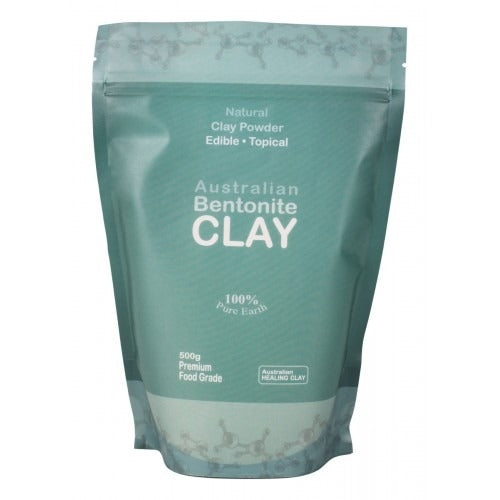Australian Healing Clay | Bentonite Clay
- Low stock - 2 items left
- Backordered, shipping soon
About Clay
Around 200 million years in the making clay comes in a variety of colours, which vary according to its mineral content. Bentonite, also known as montmorillonite is of the smectite class of clays. It is derived from deposits of weathered volcanic ash. A good quality Bentonite has high absorptive properties and a high cation exchange or drawing power, it has a very fine, velveteen feel and is odourless and non-staining. While it contains a wide variety of trace minerals, these minerals are not absorbed from applying clay to the body. High bonding between these minerals prevents absorption. It is however one of the most effective natural cleansing and purifying agents available.
Clays are alumino-silicates and their performance properties are related to their weak silica-alumina bond. Bentonite is a dioctahedral smectite (an expanding layer silicate). Typically it is composed of Alumina oxide (Al2O3) and Silica - SiO2. Alumina oxide is NON-TOXIC and not to be confused with the manufactured aluminium (Al) which is toxic.
It is also made up of a number of other minerals some of which have exchangeable ions. Typically they are - sodium ions, calcium ions, potassium ions, magnesium ions.
Bentonite is known for its highly absorptive properties and its ability to adsorb (attach to) and bind with certain substances. The Egyptians used it to preserve their famous mummies. The ancient Greeks and Romans used it to for a variety of applications in daily life. The great German Naturopaths of the last century hailed clay as one of nature’s great gifts. Numerous so called ‘primitive’ tribes have used clay both internally and externally.
According to Robert T. Martins, B.S.,a mineralogist University of Minnesota; Ph.D., Cornell University and Mineralogist at Massachusetts Institute of Technology, the molecular surface of one gram (1/28th of an ounce ) of Bentonite Clay has a surface area of 800 sq. meters. Not all clays are the same though and not all clays can achieve the same results.
Australian Bentonite Clay - Food Grade
Edible ~ Topical
This premium Australian Bentonite Clay is among the finest clay available in the world today. It has been carefully selected for its purity and performance and is excellent for all your wellness protocols as well as your body care applications.
It has a very smooth creamy texture and easily mixes with water or into a smoothie. For topical use it is suitable for even the most sensitive skin.
- Safe to ingest.
- Food standards Australia & New Zealand compliant. (FSANZ)
- Guaranteed Sundried
- Natural clay powder only; guaranteed no additives.
- Unprocessed, dry milled only.
- Instructions on label
- Product of Australia
BODY CARE - topical applications
- Clay Bath
- Facial
- Footbath
- Body wrap
How does clay work?

Adsorption & Absorption
The words adsorption and absorption may sound similar but they are fundamentally different in the functions they represent.
" What takes place is actually an ion
exchange which is often described as
a magnetic or drawing effect.
It is electrical attraction."
Adsorption describes how clay is able to attach to other substances. The clay molecule can perhaps be pictured as a stack of business cards with space between them. Around the edge of these cards is a negative electrical charge of unsatisfied ionic bonds. These ions naturally seek to be satisfied and therefore when in contact with substances that carry the opposite (positive) electrical charge an ion exchange takes place.
Pollutants and toxic substances carry a positive electrical charge.
Absorption is the when clay swells and is stretched open like a highly porous sponge, drawing pollutants and toxins etc. into its internal structure, literally locking them away.
The greater the surface area the greater the power to pick up positively charged particles.
According to Robert T. Martins, B.S.,a mineralogist University of Minnesota; Ph.D., Cornell University and Mineralogist at Massachusetts Institute of Technology, the molecular surface of one gram
(1/28th of an ounce ) of Bentonite Clay has a surface area of 800 sq. meters
Not all clay is the same though and not all clays can achieve the same results.
Ran Knishinsky writes " I have seen a variety of Bentonite clays where each one looked, felt, tasted, and acted different from others. They did so because they were not the same clays"
Bentonites value lies in its fine molecular particle size and very loosely bound ions that are easily exchangeable.





